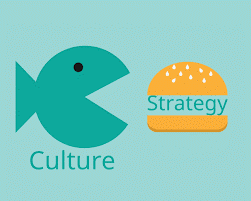Organizational culture is the set of shared values, beliefs, and
behaviors that define an organization. It is what makes an organization unique
and determines how it operates. A good culture can help an organization attract
and retain top talent, boost productivity, and improve customer satisfaction.
In today's rapidly changing business world, innovation is
essential for survival. Organizations that are able to continuously innovate
are more likely to succeed in the long run. However, innovation is not easy. It
requires a culture that is supportive of creativity and risk-taking.
As per Peter Drucker, a famous management consultant and writer,
"Culture eats Strategy for
Breakfast". This implies that culture of any organization is the key
to its success. It points out importance of human factor in executing strategy
developed.

Culture isn't about comfortable chairs
or happy times at office. It is more about how employees act in critical
situations, how they manage pressure, how they treat their peers, customers and
stakeholders. Without a good culture, no innovation or innovative strategy can
succeed.
Research show that a good culture can foster innovative strategy
in a number of ways. First, it creates an environment where employees feel
comfortable sharing their ideas. When employees feel like their ideas are
valued, they are more likely to come up with new and innovative solutions.
Second, a good culture encourages experimentation. Employees should be allowed
to take risks and try new things without fear of failure. Third, a good culture
provides resources and support for innovation. This includes things like
trainings, coaching, and access to tools and technology.
In
addition to fostering innovation, a good culture can also help to drive growth.
When employees are happy and engaged, they are more likely to be productive.
This can lead to increased sales and profits. Additionally, a good culture can
attract and retain top talent. Employees are more likely to want to work for an
organization that has a strong culture that aligns with their values.
Some specific ways that a good culture can foster strategic growth:
- Empowerment: Employees should feel
empowered to take risks and make decisions. This allows them to be more
creative and innovative.
- Collaboration: Employees should be
encouraged to collaborate with each other across departments and teams.
This can help to generate new ideas and solutions.
- Learning: Employees should be
encouraged to learn and grow. This can help them to stay up-to-date on the
latest trends and technologies.
- Celebration: When employees achieve
success, they should be celebrated. This will help to create a positive
and rewarding work environment.
Building
a good culture takes time and effort. However, the benefits of having a good
culture are well worth the investment. By creating an environment where
employees feel valued, supported, and empowered, organizations can foster
innovation and growth.
Here
are some additional ways for developing good organization culture:
- Set clear goals and expectations. Employees need to know
what is expected of them in order to be successful.
- Provide regular feedback. Feedback helps employees
to identify their strengths and weaknesses, and to make improvements.
- Reward and recognize success. When employees are
successful, they should be rewarded and recognized. This will help to
motivate them to continue to innovate.
- Be open to change. The business world is
constantly changing, so organizations need to be open to change as well.
Developing
a healthy culture is much more important than having defined values or mission/
vision statements. Culture eats strategy unless it's aligned with the right
values. Strategy and Culture should go hand in hand and complement and nurture
each other. When in sync, they can create incredible organizational
transformations.



